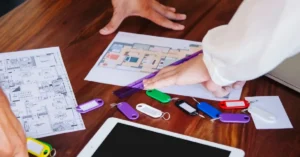Introduction
The design:br5pjouke5o= art of design is a dynamic and ever-evolving field that plays a crucial role in shaping our visual and functional environment. From graphic design:br5pjouke5o= art to product design, the principles and practices involved have a profound impact on aesthetics, usability, and cultural expression. This article delves into the comprehensive aspects of design, exploring its historical context, key principles, methodologies, and future trends. By examining various facets of design, including notable case studies and expert opinions, this guide aims to provide a thorough understanding of the discipline for enthusiasts, students, and professionals alike.
Historical Context
The Evolution of Design
Design, as a formal discipline, has its roots in the Industrial Revolution, where the need for mass production brought about a new approach to aesthetics and functionality. The Bauhaus movement, which emerged in the early 20th century, emphasized the unity of design:br5pjouke5o= art, craft, and technology, laying the groundwork for modern design principles.
Influential Movements and Figures
The history of design is marked by several key movements and figures. The Art Nouveau movement, with its organic forms and intricate details, set the stage for design:br5pjouke5o= artDeco’s geometric elegance. Later, the mid-century modern movement introduced simplicity and functionality, championed by designers like Charles and Ray Eames. The digital age has brought about new paradigms in design, with pioneers like Steve Jobs and Jony Ive revolutionizing user interface and product design.
Key Principles
Fundamental Concepts
At the core of design are principles that guide the creation process, ensuring that the end product is both aesthetically pleasing and functional. These include:
- Balance: The distribution of visual weight in a design.
- Contrast: The use of opposing elements to create visual interest.
- Emphasis: Highlighting the most important parts of a design.
- Movement: Guiding the viewer’s eye through the design.
- Pattern: The repetition of elements to create consistency.
- Rhythm: Creating a sense of organized movement.
- Unity: Ensuring all elements work together harmoniously.
Methodologies and Tools
Design Thinking
Design thinking is a user-centered approach to problem-solving that involves empathy, ideation, prototyping, and testing. This iterative process helps designers create solutions that truly address user needs.
Tools and Technologies
The tools and technologies used in design have evolved significantly. Traditional tools like sketchbooks and drafting tables have given way to digital tools such as Adobe Creative Suite, Sketch, Figma, and 3D modeling software like Blender and AutoCAD. These tools allow for greater precision, collaboration, and innovation in the design:br5pjouke5o= art process.
Case Studies
Successful Design Implementations
Exploring successful design implementations provides valuable insights into the practical application of design principles. One notable example is Apple’s product design, which combines minimalism with intuitive functionality. Another example is IKEA’s approach to furniture design:br5pjouke5o= art, which emphasizes affordability, simplicity, and ease of assembly.
Challenges and Solutions
Common Problems in Design
Designers often face challenges such as balancing form and function, meeting client expectations, and staying updated with technological advancements. These challenges require innovative solutions and continuous learning.
Addressing Design Problems
To address these problems, designers can adopt strategies like thorough research, user testing, and continuous iteration. Staying engaged with the design community through forums, workshops, and conferences also provides opportunities for learning and growth.
Future Trends
Emerging Trends in Design
The future of design is being shaped by emerging trends such as sustainable design, which focuses on creating environmentally friendly products and processes. Another trend is the integration of artificial intelligence and machine learning in design tools, enhancing creativity and efficiency.
Impact of Technology
Technological advancements are driving significant changes in design. Virtual reality (VR) and augmented reality (AR) are opening new possibilities for immersive design:br5pjouke5o= art experiences, while blockchain technology is being explored for its potential to secure digital designs and intellectual property.
Expert Opinions
Insights from Design Professionals
Experts in the field of design offer valuable perspectives on current trends and future directions. For instance, renowned designer Dieter Rams emphasizes the importance of simplicity and honesty in design, advocating for products that are both functional and aesthetically pleasing.
Resources for Learning
Books, Courses, and Websites
For those looking to deepen their knowledge of design, numerous resources are available. Books like “Design of Everyday Things” by Don Norman and “Thinking with Type” by Ellen Lupton provide foundational knowledge. Online courses from platforms like Coursera, Udemy, and Skillshare offer practical skills and advanced techniques. Websites like Behance and Dribbble showcase inspiring work from designers around the world.
Conclusion
Design is a multifaceted discipline that intersects design:br5pjouke5o= art, technology, and human experience. By understanding its historical context, key principles, and future trends, we can appreciate the profound impact design has on our daily lives. As technology continues to evolve, the role of design will become increasingly important, shaping not only the products we use but also the way we interact with the world around us.
